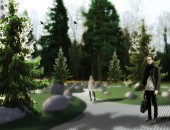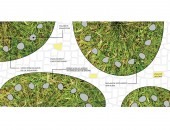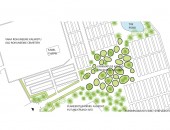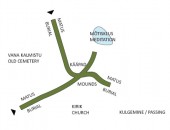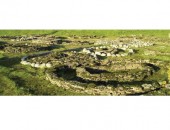Rohuneeme Cemetery urn burial development in Viimsi.
Winning proposal
Architects:
Ingrid Aasoja, Aleksandr Zverev
Art critic:
Mait Väljas
Competition entry: 2010
At the tip on Viimsi Peninsula near the sea in a beautiful quiet natural surroundings is Rohuneeme Cemetery. This competition proposal KÄÄPAD (MOUNDS) seeks to develop the urn burial area to quietly blend in the natural environment.
The design was led by Ancient Estonian burial sites and natural environment of Rohuneeme Cemetery. Urn burial freeform mounds and freeform granite gravestones are both derived from the ancient barrows and tumuluses. The woods-like feeling in the area was derived from ancient sacred groves and the natural surroundings.
The site design is free from hierarchy and can be built either at once or mound by mound. Therefore it never looks as if it is unfinished or that some burials are too far away from the others.
Mounds itself are piled ground with urn burials in th eperimeter. The vegetation on the mounds is natural Estonian forest vegetation with long grass, fir, cowberries etc.
Between the mounds and planned church there is planned a fir grove. In the North-East end of the Cemetery a pond with trees around has been planned. This will be the place for rest and meditation.
Winning proposal
Architects:
Ingrid Aasoja, Aleksandr Zverev
Art critic:
Mait Väljas
Competition entry: 2010
At the tip on Viimsi Peninsula near the sea in a beautiful quiet natural surroundings is Rohuneeme Cemetery. This competition proposal KÄÄPAD (MOUNDS) seeks to develop the urn burial area to quietly blend in the natural environment.
The design was led by Ancient Estonian burial sites and natural environment of Rohuneeme Cemetery. Urn burial freeform mounds and freeform granite gravestones are both derived from the ancient barrows and tumuluses. The woods-like feeling in the area was derived from ancient sacred groves and the natural surroundings.
The site design is free from hierarchy and can be built either at once or mound by mound. Therefore it never looks as if it is unfinished or that some burials are too far away from the others.
Mounds itself are piled ground with urn burials in th eperimeter. The vegetation on the mounds is natural Estonian forest vegetation with long grass, fir, cowberries etc.
Between the mounds and planned church there is planned a fir grove. In the North-East end of the Cemetery a pond with trees around has been planned. This will be the place for rest and meditation.


